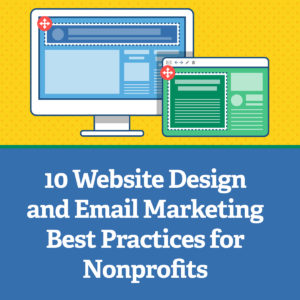Growing the size of your email list is an important strategic goal for your nonprofit's marketing, communications, and fundraising programs. Even with average email open rates under 20 percent, email is consistently the best performing communications tool for most nonprofits. It requires significant effort and discipline to keep building your email list, month after month.
And yet, it's important to make the effort, becauses email "churn" eats away at the size of your file as people change email addresses, close accounts, and change jobs. Also, to maintain the strong attention span of that core 20 percent of your list, you'll need to keep bringing on new engaged subscribers every day.
There are several effective free techniques to grow your email list using the current digital assets and online properties your organization already has. So before you spend money to rent email lists, distribute an email offer through a media platform, or work with a paid co-registration service such as Care2.com, consider the following. These free ideas and strategies will build your email file by tapping into your current website traffic and social media follower community.
Optimize the Email Signup Offer on Your Website Home Page
Your home page is usually the page that receives the most visitor traffic on your website, so it's critically important to optimize its email signup offer. Optimizing entails determining the best location for your email signup widget and the most effective language to drive the strongest signup activity.
The best location for an email signup widget is usually in the upper half of the page, either as part of the top navigation, or simply above the fold for larger screens. Furthermore, consider how people visiting your website with a mobile device such as a phone or smaller tablet will view the widget and fill it out. If your website is responsive for mobile devices, it will hopefully enlarge the widget for ease of use, otherwise the form will be small.
Be sure to check out Google Analytics to understand how many of your website visitors are using mobile devices and tablets. If your mobile traffic is over 20 percent, then it's important to consider the mobile user experience when optimizing the email signup offer on your home page.
It's also essential to determine the best language to encourage email signups. Too often, organizations use something bland like "Email signup" or "Get our newsletter," without considering how other language might improve response. Focusing on an issue or program area or simply using mission-based language may make a bigger impact.
Try "Get our Monday Activist Bulletin" or "Get weekly vegan recipes" or "Get weekly tips to expose police violence." This sort of language usually improves the signup rate.
Optimize the Email Signup Offer on Your Other Top 10 Pages
Although your website home page is your first priority, don't neglect to optimize how the offer is presented on your other top 10 traffic pages. If your email signup offer is built into the navigation at the top of every page, that's excellent. But otherwise, make sure that your email offer is clearly visible, either as part of a sidebar or a callout bar in the middle of the page.
Again, be sure to review how these pages will look on smaller mobile devices. If you have an appetite for more marketing data, you can set up a Google Analytics goal to measure which pages deliver the most email signups. Then you can focus your ongoing efforts to optimize the placement of the widget and the signup language.
Test Out a Digital Download to Capture Email Addresses
A proven technique to capture email addresses either from your website visitors or your social media followers is to offer a digital download. A visitor is invited to download the item you're offering in exchange for their email signup. Easy-to-create digital downloads include high resolution desktop images for larger computer screens, or smaller images for mobile phone lock screens.
Other options could be exclusive essays or a collection of article reprints in PDF format. Additional popular options include exclusive audio interviews or video compilations. Try testing a series of these digital downloads over several months to assess what works best.
Don't forget to test out these digital downloads with your social media follower community. Use a graphic image to display the offer and then create a trackable link to a page on your website where the download activity takes place. Be sure to use a Google Analytics goal to measure the impact of your social media offers.
Consider Using a Pop-up Lightbox on Your Website
Once you're comfortable offering a digital download and you've optimized your messaging techniques, consider using a pop-up lightbox on your website to present it more directly in front of your audience. While this is a more forceful marketing technique, it's also highly effective, and may be something you could use a few times a year.
Try a List Exchange or a Chaperone Email to Reach New Audiences
Another free technique to build your email list is to work with a like-minded organization, a publisher, a media property, or a corporate partner. All of these entities can help get your message in front of new audiences.
The "list exchange" is a reciprocal agreement that two organizations will each send an email message to their list, introducing a project that the other organization is engaged in. This sort of movement building activity is an effective way to seek out new email subscribers. It's common for two organizations to agree to email the same number of constituents and sometimes to exclude active donors from that list.
A variant on this technique is a chaperone email. A publisher, media property, or corporate partner will promote your campaign via email, website feature, or social media posting, as part of a strategic partnership.
Image: Constantin Stanciu / Shutterstock




